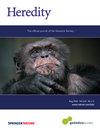最近热带干旱森林热点的栖息地改变驱动墨西哥叶蛙种群遗传分化:景观遗传学方法
IF 3.9
2区 生物学
Q2 ECOLOGY
引用次数: 0
摘要
热带干林(TDF)是毁林率和转化率最高的生态系统之一。由于栖息地的丧失和破碎化,经过改造的景观可能对个体的迁移施加阻力,并产生重要的遗传后果。由于栖息地的改变,受影响最大的分类之一是两栖动物,它们目前在全球范围内面临着极端的数量下降。本研究利用单核苷酸多态性(snp)分析了墨西哥TDF生物多样性热点地区墨西哥树蛙(Agalychnis dacnicolor)的遗传多样性、遗传结构以及景观因素对其遗传连通性的影响。我们在Chamela-Cuixmala地区的TDF破碎区和连续森林内的16个地点收集了96个个体的样本。破碎林取样点的遗传多样性和有效种群规模略低于连续林取样点。我们发现了3个混合遗传群,其中破碎林内的大部分位点与连续林内的位点有分化。虽然这些分析表明了历史上的基因流动,但我们没有发现三个遗传群体之间的近期显著迁移。原始植被(TDF +热带常绿森林)和一些地区的农业促进了遗传连通性,而开放地区(草原+人类住区+暴露土壤)和其他地区的农业则限制了白毛杨的遗传连通性。本研究有助于理解在高度变化的复杂景观中形成当代人口差异的因素,并强调了在快速变化的生态系统中保持连通性的重要性。本文章由计算机程序翻译,如有差异,请以英文原文为准。

Recent habitat modification of a tropical dry forest hotspot drives population genetic divergence in the Mexican leaf frog: a landscape genetics approach
Tropical dry forests (TDF) are among the ecosystems with the highest deforestation and transformation rates. Because of habitat loss and fragmentation, modified landscapes can impose resistance to the movement of individuals, with important genetic consequences. One of the most affected taxa due to habitat alteration are amphibians, which currently face extreme population declines globally. Here, we used single nucleotide polymorphisms (SNPs) to evaluate genetic diversity, genetic structure, and the effect of landscape elements on genetic connectivity of the Mexican tree frog (Agalychnis dacnicolor) in a TDF biodiversity hotspot in Mexico. We collected samples of 96 individuals from 16 sites located within fragmented areas of TDF and within continuous forest in the Chamela-Cuixmala region. Sampling sites from the fragmented forest showed slightly lower genetic diversity and effective population size compared to those in the continuous forest. We detected three admixed genetic groups, in which most of the sites within the fragmented forest were differentiated from the sites within continuous forest. Although these analyses suggest historical gene flow, we did not detect significant recent migration among the three genetic groups. While original vegetation (TDF + tropical evergreen forest), and in some areas, agriculture facilitated genetic connectivity, open-areas (grasslands + human settlements + exposed soil), and agriculture in other areas limited genetic connectivity in A. dacnicolor. This study helps to understand the factors shaping contemporary population divergence in highly modified complex landscapes, and highlights the importance to maintain connectivity in a rapidly changing ecosystem.
求助全文
通过发布文献求助,成功后即可免费获取论文全文。
去求助
来源期刊

Heredity
生物-进化生物学
CiteScore
7.50
自引率
2.60%
发文量
84
审稿时长
4-8 weeks
期刊介绍:
Heredity is the official journal of the Genetics Society. It covers a broad range of topics within the field of genetics and therefore papers must address conceptual or applied issues of interest to the journal''s wide readership
 求助内容:
求助内容: 应助结果提醒方式:
应助结果提醒方式:


